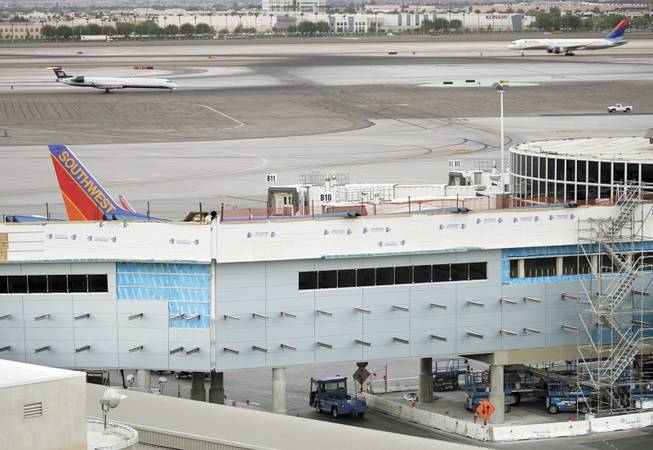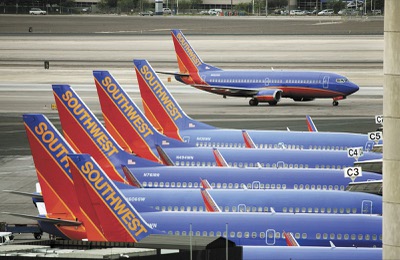
Work continues on the pedestrian walkway connecting McCarran International Airport’s B and C gates. A companion project — a security checkpoint annex with 12 lanes — is likely to open next month.
Monday, Aug. 18, 2008 | 2 a.m.
Beyond the Sun
The long-delayed skywalk connecting the B and C concourses at McCarran International Airport is no longer a bridge to nowhere, but the public still won’t be able to use it until late November at the earliest.
The pedestrian bridge was supposed to have been completed more than 10 months ago, along with a two-level security annex aimed at shortening checkpoint lines. The good news is the 12 new security lanes are scheduled to open next month.
Passengers of Southwest Airlines, the busiest carrier at the airport, will make the most use of the new C gates security annex, but the benefits should be felt by everyone flying out of the D gates as well because now they share a security checkpoint area with C gate passengers.
But the skybridge and security annex project is going to cost millions more than its initial price tag — and a battle between the contractor and the county seems likely.
The initial price of construction was $65.4 million, according to early 2006 county documents, but the cost today is pegged at $72 million. (Airport officials say that two years ago, they anticipated the cost might rise as much as 10 percent.)
But that’s just construction cost. The architectural costs went up too.
Airport executives blame “fairly significant” design flaws and a glacial construction process. Redesigns have meant architectural costs of the bridge have risen to $2.86 million, 72 percent more than the original budget of $1.66 million. But the architect, Domingo Cambeiro, says the contractor, Flagship Construction, is at fault for many of the delays and cost increases.
One problem was that the end of the bridge was 9 inches higher than its second-floor entrance to the existing B concourse, which is home to US Airways and some overflow Southwest Airlines flights.
The skyway roof had a design error too, says Randall Walker, the airport’s director of aviation. It “was sloped in both directions, so it had to be redesigned,” he says.
Flagship’s construction pace is what really irks Walker, though.
“The bridge is languishing,” he says. “What distressed me ... is that I walked (the bridge) at 3:30 p.m. on a weekday in July. And there was absolutely no one doing work out there.”
With the project behind schedule, Walker says he had expected Flagship to work diligently, perhaps add extra shifts, to get the project finished. It’s what the contractor handling the expansion of the D concourse did.
Now, Walker anticipates that when construction on the annex-bridge project wraps up, the airport and Flagship will enter legal negotiations over costs and delays.
“There will be an interesting closeout” to the project, he says. “We’re significantly at odds.”
The airport and the contractor appear to have squabbled from the beginning over the timeline. Flagship initially had difficulty securing a bond, prompting a 120-day delay, Cambeiro says. The project should have begun Feb. 20, 2006. Flagship, Walker says, sought an excused delay, which he rejected.
A Flagship official, briefly apprised of Walker’s overall remarks, offered this single statement: “The entire facts are not being portrayed accurately.”
•••
Walker acknowledges he isn’t fond of the bridge concept on principle. The airport’s priority, he explains, is to serve passengers for whom Las Vegas is a destination, not passengers who simply fly through without ever leaving the airport. But, he said, he determined the skywalk is necessary to ease mounting demand at McCarran.
Officials at carriers including Southwest Airlines and US Airways encouraged the construction of the bridge. The airlines have paid for a daily shuttle to run between the two concourses, but will discontinue the service upon the bridge’s opening, Walker says.
The idea of a bridge was conceived before the 9/11 attacks as a link between the B and C concourses, to and from the existing buildings, to prevent additional traffic on typically lengthy security lines. With a connection between concourses, passengers on layovers in one concourse wouldn’t have to pass through the security checkpoints.
The proposal was revisited in spring 2004. But before the county hired a contractor in mid-2004, airport officials scrapped that $15 million plan for a bridge alone and decided a project larger in scope, one that would address several aspects of an airport bursting at the seams, was called for. Cambeiro had begun designing the original bridge when the county called it off in favor of the larger project.
After changing yet another plan, the airport decided to group the bridge project with construction of a security annex, one with 12 lanes.
Later, with construction on the skyway and annex lagging, the airport instructed Flagship to make the annex the priority, Walker says. The annex is more critical today because the airport is opening an expanded D concourse next month. Without the 12 additional lanes, there would be even more of a crush at the existing C/D security wing.
But because multiple projects were revised and consolidated, different architects were employed. Cambeiro attended to the bridge.
“It does sound like we duplicated things,” county Commissioner Chris Giunchigliani says.
Cambeiro and his project manager, Mark Dowell, attribute the flaws in Flagship’s work on the bridge to old drawings of the existing B concourse that included errors and changes made during construction by project manager Bechtel. And communications issues between the parties further slowed the process, Cambeiro says.
The elevation of the B concourse’s second floor couldn’t be identified, he says, because his company was unable to survey it. “We couldn’t expose the floor because the concourse was in operation,” he adds.
The second floor of the two-story pedestrian bridge ultimately was sloped to accommodate the difference in elevations, Walker says.
As for the roof, Dowell alleges that Flagship “did not install the edge of the roof the way it was intended, so it created problems with the slope.” A redesign was needed.
Walker says he would welcome Cambeiro’s company back to the airport. The architect has assisted on several projects at the airport over the years, building good will. And in Walker’s view, anyone can make an error — “it’s how you deal with them that’s the issue.”
That explains much of his frustration with Flagship. But despite his preference that the county not use the company again at the airport, he doubts it will be disqualified from future projects.


Join the Discussion:
Check this out for a full explanation of our conversion to the LiveFyre commenting system and instructions on how to sign up for an account.
Full comments policy